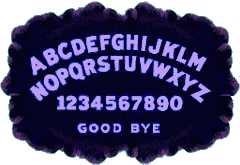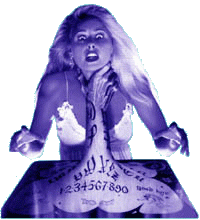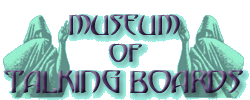

When you believe in
things
That you don't
understand,
Then you
suffer,
Superstition ain’t the
way -Stevie Wonder
“So, how do I use the Ouija board correctly and what do I need to be afraid of?”
This question, or a variation of it, is the most commonly asked about the Ouija board. It sounds like it should be. If people think they are about to talk to the dead they don’t want to get it wrong, especially if they’ve got misgivings due to horror stories they’ve heard.
In the past, Spiritualists placed little emphasis on tools like alphabet cards or tables used for spirit communication since they were considered tools without power of their own. That shifted when the talking board became popular with the masses during the 1880s. People with no spiritual interests other than entertainment suddenly had access to a seemingly magical device. Manufacturers marketed the Ouija board as a parlor game targeted for evening amusement but many saw it as something more: a thing to be feared and avoided. For the first time, you could buy and take home a scary wooden board that would connect you quite literally to death. Or, so was its reputation.
In the mid 1990s when the Museum of Talking Boards came together, Ouija boards didn’t have the popularity or acceptance that they do today. Widely denounced by the religious as being against “God’s teachings,” dismissed by skeptics as being superstitious nonsense, and considered by the occult community as being “low magic” unworthy of consideration, the poor Ouija board couldn’t get a break. Despite an earlier, largely successful, advertising push by then owner Parker Brothers, it was, at the time, treated as their dirty little secret. Customer service’s canned response to any inquiry was “thank you for liking our brand” –end of conversation. Any mention of Ouija boards in social media brought forth a slew of reasons as to why they were a very bad idea. These warnings appeared so often that I decided to collect and add them to the site as “Ouijastitions.” Interestingly, patterns emerged and it soon became clear what these superstitions meant to people, revealing as they did, preconceived fears and prejudices.
The oldest superstitious objections to any kind of spiritual communication are religious dating back centuries before the Ouija board. For many, they remain unchanged. Church teachings forbid any kind of spiritual contact unless it is the church sanctioned kind. You may pray as long as you do it in the “proper” way. “Praying” is one-way communication where “God listens” but doesn’t answer preferring instead to include you in “His Grand Plan,” whatever that might be. Praying to dead holy people is also permitted. Oddly, the idea that you might want a direct response, say with a Ouija board, is enough to get you into big trouble because, according to holy scripture, you are now a witch. Nevertheless, Ouijastitions from religious people who dabble (or would like to) in the forbidden is common. As you might imagine, these superstitions reflect faith-based beliefs and teachings:
- Witch boards are so named because witches use them to summon demons.
- A Ouija Board will scream if you try to burn it. There is only one proper way to dispose of it: break the board into seven pieces, sprinkle it with Holy Water then bury it.
- Never ask about God.
- Never ask when you are going to die.
- Never ask where the gold is buried.
- The board must be "closed" properly or evil spirits will remain behind to haunt the operator.
- When using a glass as a message indicator, you must always cleanse it first by holding it over a burning candle.
- If you must use a Ouija board, make your own. Arrange the letters and numbers, into a circle so whatever is trapped within that circle can't escape.
- If you place crystals or a pure silver coin on the board, no evil spirits will be able to come through.
- Before you begin a session, sage or smudge your board.
- Use a proper invocation before using the board.
Perhaps the most interesting Ouijastitions come from users who are not tightly moored to any specific personal philosophies. These are the not-particularly-deep thinkers who consider personal superstitions as “common sense” rules. Frequently, beliefs come from a basic misunderstanding of the premise like mistaking the word “Goodbye” as a method to properly “close” the board (dismiss the spirit) rather than as a message from the board. They try to make sense and order where both may be lacking: “If the planchette falls from a Ouija board, a spirit will get loose.” Historical facts with some legitimacy often get hilariously mangled: “The very first Ouija boards were made from the wood of coffins.” The narrative is that something very scary is going to happen, so you better watch out. Warnings abound:
- Never let the spirits count down through the numbers or go through the alphabet as they can get out of the board this way.
- If the planchette goes to the four corners of the board it means that you have contacted an evil spirit.
- If the planchette falls from a Ouija board, a spirit will get loose.
- If you should get an evil spirit, quickly turn the planchette upside down and use it that way.
- Never use the Ouija when you are ill or in a weakened condition since this may make you vulnerable to possession.
- Evil spirits contacted through the Ouija board will try to win your confidence with false flattery and lies.
- Always be respectful and never upset the spirits.
- Never use the Ouija in a graveyard or place where a terrible death has occurred or you will bring forth malevolent entities.
- The very first Ouija boards were made from the wood of coffins. A coffin nail in the center of the planchette window served as the pointer.
- Ouija boards that are disposed of improperly, come back to haunt the owner.
- NEVER leave the planchette on the board if you aren't using it.
- When you are done with your session, ALWAYS say "goodbye."
- If the planchette repeatedly makes a figure eight, it means that an evil spirit is in control of the board.
Movies and television
have tremendous influence on what people believe and
often reinforce Ouija board folklore. One movie, the
1973 film, The Exorcist, stands above the
rest lately thanks to Internet social media. The
supposition is that before The Exorcist, the
Ouija board was a harmless parlor game but now,
thanks to the movie, everyone thinks it’s evil.
Nothing could be further from the truth. According to
historical records, the Ouija has always had a
reputation and that’s because although times change,
people don’t. Most who believe The Exorcist myth,
which by now has become a Ouijastition of its own,
never saw it in the theater and so were unable to
take in the full movie experience. Reviewers at the
time never mentioned the Ouija scene because it was
so eclipsed by the horrible things that happened to
the main characters. It was only later with the
film’s release to video and DVD that the Ouija scene
gained attention. Still, you’ll see this repeated
again and again especially among new users defending
the Ouija board. 
One movie with a definite influence on popular thinking was the 1986 film Witchboard. Writer and producer Kevin Tenney masterfully condensed several Ouijastitions to fit his script:
- Never play alone!
- Every board has its dominant spirit.
- The spirit of the Ouija board creates "wins" for the user, causing her to become more and more dependent on the board. Addiction follows. This is called "progressive entrapment." Ultimately, the spirit can completely possess the user.
Even though many may have never seen the movie Witchboard, these ideas spread unchallenged in online forums and on personal websites.
Speaking of the Internet, the latest Ouija super-villain to make the rounds is an evil spirit named ZOZO. According to a recent report: “He has been known to rape his victims, completely drain people of all happiness and joy, leaving them depressed and suicidal. He feeds off all the negativity that your soul can produce, slowly getting stronger until he is strong enough to actually hurt you, rape you, and possess you.” Variations of this warning are common. It doesn’t occur to believers that if this were even remotely true it would be on the cover of every newspaper and magazine in the nation. Fox News would be running coverage 24 hours a day. Fortunately, viewers in Ouija groups and other forums are tiring of this madness and will flame ZOZO zealots unmercifully or have them banned completely.
I’ve said elsewhere on the site that we love the Ouija’s controversial reputation. Without that it would be a whole lot less interesting and just another board game. Suspending disbelief while connecting to something mysterious is what makes the board both magical and exciting. This very attraction and interaction allows users to express themselves in many different, mostly positive, ways. There is even a Talking Board Historical Society dedicated to celebrating and preserving the Ouija’s history and lore. It’s important to remember that millions of Ouija boards are sold worldwide every year and used with no ill effects whatsoever. And lastly, there are no “set of rules” to follow or prohibitions to obey in order to have successful sessions. “Your way,” whatever that may be, is the best way. Although it’s encouraged and recommended to seek advice from successful users, it’s also important not to buy into baseless warnings or admonitions against use. Superstitions are what they are: false beliefs, steeped in fear with no basis in truth.
Ouija-stitions | Interactive | Books | Movies | Collect | Buy | Links | e-mail
*
That's Ami
Dolenz in Witchboard 2: the Devil's
Doorway,
Republic Pictures Corporation 1993.
Keep telling yourself: "It's only a movie; it's
only a movie!"

Copyright © All Rights Reserved.